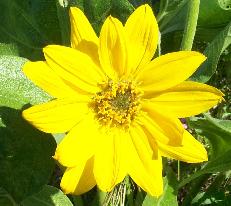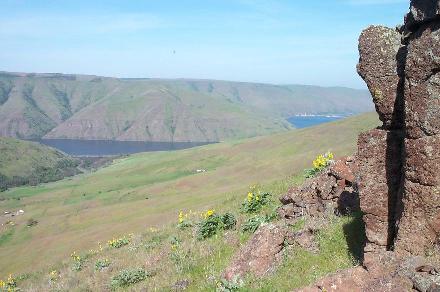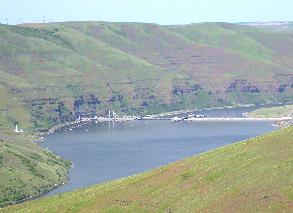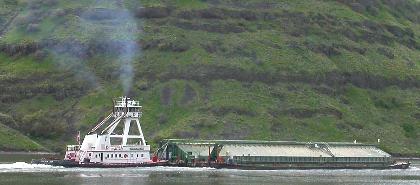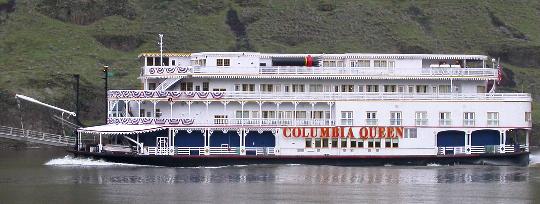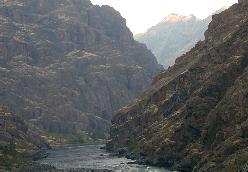 Wawawai and Snake River Canyons
Wawawai and Snake River Canyons
|
Use your browser's "back" feature to return to this page
|

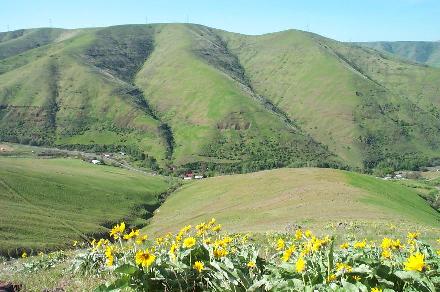
|
Wawawai (waa-WAA-wee) Canyon in April. This is about
as green as it ever gets. Winter rains recharge the soil of this arid
land and the pastures yield a spurt of growth. By mid-June this
freshness gradually fades; by July all becomes scorched tan.
You can see the white roofs of our house and garage at the bottom of the gully at the left. The red roof belongs to the house on the far side of the highway.
Enlarged view, 101kb.
|
|
Orrin got out of shape over the winter of 2001/2002, so he began daily climbs this far up the canyon's north wall. This vantage point sits about 1,000 feet above the house. The transmission line steel towers are a bit over a mile away. Another 3 to 500-feet of vertical ascent brings one to the canyon rim. Loose rock and a steeper incline make it impractical to go higher on daily outings. The less-than-sure footing increases the of odds of taking a fall. But, for the sake of variety, it's fun to go all the way to the cropland, above, and follow another ridge back down. A view from the top allows one to look over the power line ridge and see the Blue Mountains in the distance. The "Blues" don't look like mountains at all. They appear as a huge mound on the horizon.
|


|
Lower Granite Dam appears in the distance, a bit over four miles away. I worked there as a power plant operator from 1976 until my retirement in 1996. Each day (or night) I'd launch our boat at Wawawai Landing, just out of view to the left, and motor the four miles to the dam. I'd tie off at the navigation lock upstream guide wall and walk across to the south end where the control room is located. It sounds time-consuming, but it wasn't all that bad. My record time from inside our house to the control room was something like twenty minutes.
|

|
The series of dashes are the eight spillway gates. The structure pointing up-stream/down-stream is the navigation lock. Protruding into the forebay is the floating guidewall leading into the lock. Because the water is well over 100-feet deep, here, it is impractical to build a guidewall that rests on the bottom. So, this all concrete structure was designed to float. (It is hollow, like a boat.) I kept my boat tied off to the guidewall while on duty. The right hand side consists of the earth-filled portion of the dam. Lower Granite is the last of a series of eight locks and dams that permit vessels to navigate from the Pacific Ocean to the "seaport" of Lewiston, Idaho. Most of the cargo is hauled in barges of about 3,000-tons capacity. The lock will accomodate a tow of five barges and one tugboat. Mostly, the commodities consist of wheat (from as far away as North Dakota), logs, wood chips, paper products from the Potlatch mill in Lewiston, dried peas and lentils, and petroleum products.
|


|
Enlarged view, 73kb
Note that the faux smokestacks have been lowered to clear bridges and navigation lock structures. The Columbia Queen is not a sternwheeler, but another cruise boat, the Queen of the West, graces these waters sporting a handsome stern wheel.
|

|
Even at a comparatively shallow 1,500-feet, our canyon enjoys its own
micro-climate, sometimes being as much as 20-degrees warmer in the
winter than the surrounding countryside. It's an added curse in the
summer months, though, typically being 5 to 7-degrees hotter. The
complete absence of humidity makes it very tolerable, however, and in
the evening the cooler air flows down from above.
An added bonus to our dry climate is the freedom from mosquitoes. We can enjoy our evenings outdoors without being eaten alive. |

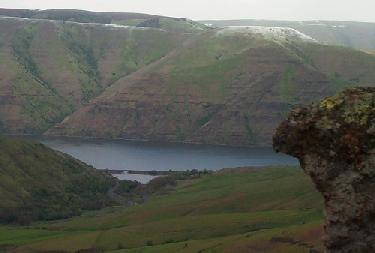
|
Like the brooding Hells Canyon, ours has its moods, too.
This May 7th scene would produce a flurry of poetry from the likes of Poe.
Enlarged view, 59kb.
|

|
A look to the east brought no hope for a warming ray of morning sun.
Enlarged view, 85kb
|
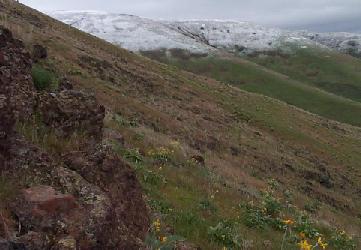
|

Click here to see more of the canyon
or,
Click here to return to Orrin & Cathy's opening page
Copyright © 1998-2007, Orrin B. Iseminger
Revised -- 1/18/07
 Wawawai and Snake River Canyons
Wawawai and Snake River Canyons
